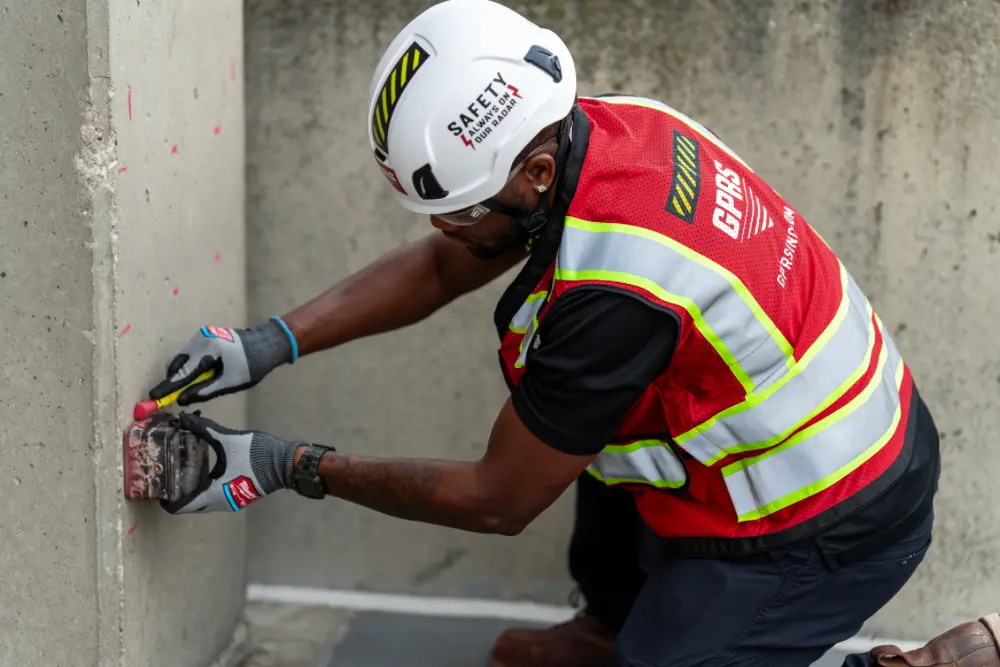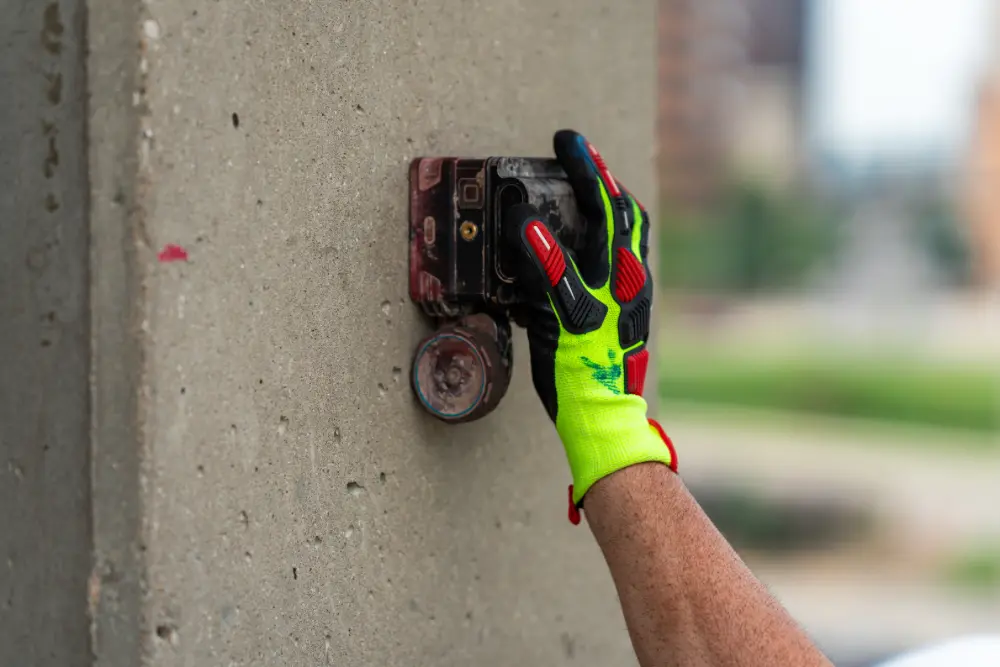Post-tensioned (PT) concrete construction is widely used in commercial, residential, and industrial building projects for its efficiency and strength.
By applying tension to steel tendons within the concrete after it has cured, post-tensioning allows for thinner slabs, longer spans, and reduced cracking. But these benefits come with a unique set of challenges—especially when it comes to cutting or coring near structural elements like columns.
Any modification to a PT concrete slab near a column must be approached with the utmost caution. Cutting in these areas without proper preparation can compromise the structural integrity of the building, sever vital reinforcement cables, or even cause catastrophic failure.
This is where the expertise of a professional concrete scanning company like GPRS becomes indispensable. Using advanced ground penetrating radar (GPR) scanners and other complementary technologies, our Project Managers can identify and mark safe zones, ensuring that cutting work is both precise and secure.

Understanding Post-Tensioned Construction Near Columns
Post-tensioned slabs contain steel tendons that are tensioned after the concrete has hardened.
Concrete is weak in tension and strong in compression. A slab has tension points at the bottom of the slab between the beams and column lines and has tension at the top of the slab at the beams and/or column lines.
Steel is very strong in tension. Combining steel reinforcing with concrete takes advantage of the strengths of both materials. But their strengths can be taken advantage of in an even greater way by actively putting the steel into tension by using post tension cables.
Tensioning the cables also puts the concrete into compression, which is its strongest state.
By draping the cables over the column lines, the tension in the concrete is counteracted in the appropriate places. When the cables are tensioned, they will be trying to lift up when they are at the bottom of the slab, which will provide support where the slab is trying to sag downward. The cables will also be pushing down when they are high in the slab and counteracting the tension at the top of the slab due to the columns and/or beams.
The post tension tendons run through ducts in the slab and are stressed to extremely high levels—often between 33,000 and 43,000 pounds of force per tendon (lbf/tendon or lbs/tendon).
Post tension cables are typically encased in a grout sheath, which is a cementitious material that fills the space around the steel strands. This material acts as a physical barrier protecting the steel strands from water, oxygen, and carbon dioxide – and therefore, preventing corrosion.
The use of PT cable allows for thinner slabs and eliminates the need for support beams and therefore allows for more vertical space. It also frees up designers to create more uniquely shaped concrete slabs, ramps, curves, and more.
But cutting or nicking even one PT cable can release its stored energy in a sudden and dangerous burst. In some cases, severed cables have shot out of the concrete, causing injuries or property damage.
Columns, being primary load-bearing elements, are focal points for tendon congestion. More tendons typically converge near columns than in other areas of the slab, making the risk of accidentally cutting one significantly higher. Columns are also often surrounded by stirrups, rebar, and embedded utilities, creating a dense web of potential hazards that cannot be detected with the naked eye.
The Dangers of Improper Cutting
Cutting or coring without hiring a professional concrete imaging company like GPRS to clear locations near a column in a PT slab can have serious consequences. Here are some of the most critical risks:
- Severing Post-Tension Tendons: This can result in sudden cable recoil, injuries, expensive repairs, and structural compromise.
- Damaging Rebar: Rebar is essential for slab integrity. Damaging it may weaken the area around the column, which is already under heavy load.
- Cutting Through Embedded Utilities: Electrical conduit, plumbing, and HVAC lines are often embedded in slabs. Accidental damage can cause delays, fires, or flooding.
- Structural Instability: A column is a load path. Damaging structural elements near it can lead to settlement, cracks, or even partial collapse in severe cases.
- Code Violations and Liability: Building codes typically require scanning in PT slabs before any cutting or coring. Skipping this step can result in fines, legal liability, and insurance claims.

The Role of Professional Concrete Scanning
This is where professional concrete scanning companies like GPRS step in. We utilize ground penetrating radar (GPR) and other complimentary technologies to clear safe cutting and coring locations not only around columns, but wherever you need to work along a concrete slab.
GPR scanners emit radio waves into a slab, then detect the interaction between those waves and any embedded objects like post tension cable, rebar, or conduit. Those interactions are then displayed in a readout as a series of hyperbolas, which vary in size and shape depending on what type of obstruction was located.
GPRS Project Managers are specially trained to interpret this data to tell you what was located and provide the approximate depth of those objects.
GPR is fast, safe, and accurate. Unlike concrete X-ray, which require access to both sides of the slab and poses radiation hazards, GPR can be used from one side and poses no health risks. It’s highly effective even in congested areas near columns and can identify the approximate depth and orientation of structural elements.
The Process: What to Expect When GPRS Scans Your PT Slab
When you hire GPRS to scan a PT slab near a column, we’ll follow our standard process for precision concrete scanning:
- Initial Assessment: A site visit to understand the scope of the work and identify areas of concern.
- Surface Preparation: Cleaning the surface for optimal GPR signal penetration.
- Scanning: Using handheld GPR units, our Project Manager will scan the target area. We perform long scans across the slab to identify the bottom of the slab, reinforcing pattern, PT cable pattern, and type of slab. If space is limited, we’ll move to open areas to perform long scans to understand these patterns before moving back to the project area. For slab-on-grade projects, we’ll also check our work with a passive sweep of an electromagnetic (EM) locator looking for any conduits in the area.
- Marking the Slab: Safe cutting and coring zones are clearly marked with green boxes on the surface using paint or chalk. Tendons, rebar, and utilities are color-coded for easy identification.
- Reporting: GPRS Project Managers leave you with detailed scan reports, complete with images and notes, which can be archived for future reference or shared with engineers and contractors. And all this data is uploaded into SiteMap® (patent pending), our interactive infrastructure mapping platform that provides accurate existing conditions documentation to protect your assets and people.
- On-Site Consultation: Our Project Manager will walk through the findings with your team, answering questions and making recommendations. If your initial cutting or coring locations are determined to be unsafe, we’ll suggest alternative locations that are clear of buried obstructions.
Why Experience Matters
While GPR technology is powerful, its effectiveness depends heavily on the skill of the technician using it. Reading and interpreting the images produced by GPR requires training and hands-on experience. PT tendons and rebar, for example, can produce similar signatures – and a misread can lead to unsafe cuts.
That’s why it’s essential to hire a specially trained, experienced concrete scanning company like GPRS, which adheres to the Subsurface Investigation Methodology (SIM).
Benefits of Hiring a Professional Scanning Company Like GPRS
- Enhanced Safety: Prevent accidents, injuries, and unplanned structural issues.
- Reduced Liability: Documented scans demonstrate due diligence, which can be critical in legal or insurance claims.
- Cost Savings: Avoid expensive repairs and downtime by getting it right the first time.
- Improved Project Scheduling: Fast, efficient scanning allows you to stay on track without unnecessary delays.
- Peace of Mind: Knowing that your work area is safe means fewer surprises and smoother execution.
Don’t Cut Corners Near Columns
Post-tensioned concrete offers a host of structural advantages—but it demands respect, especially near load-bearing elements like columns.
Cutting or coring in these high-risk areas without first having proper scanning completed can have disastrous consequences. A single severed tendon can jeopardize not only the structure, but also the safety of everyone on site.
GPRS Concrete Scanning Services ensure that you’re making informed decisions, protecting your team, and delivering high-quality work that stands the test of time.
What can we help you visualize?
Frequently Asked Questions
How is GPR used to identify tendons vs. rebar in a post-tensioned slab?
In post-tensioned structures, we typically find one mat of support rebar near the base of the slab. This mat is generally consistently spaced and remains at a constant elevation. Post-tension cables are generally found above this support mat and “draped” throughout the rest of the structure. The elevation of the cable is usually high near the beams and column lines and drapes lower through the span between beams and column lines. Knowledge of these structural differences allows us to accurately differentiate between components. Our Project Managers will leave you feeling confident in our findings and in your ability to drill or cut without issue.
Can GPR determine the difference between rebar and electrical conduit?
Ground penetrating radar can accurately differentiate between rebar and electrical conduit in most cases. We have an extremely high success rate in identifying electrical lines in supported slabs or slabs-on-grade before saw cutting or core drilling.
Additionally, GPRS can use EM locators to determine the location of conduits in the concrete. If we can transmit a signal onto the metal conduit, we can locate it with pinpoint accuracy. We can also find the conduit passively if a live electrical current runs through it.
The combined use of GPR and EM locating allows us to provide one of the most comprehensive and accurate conduits locating services available.
